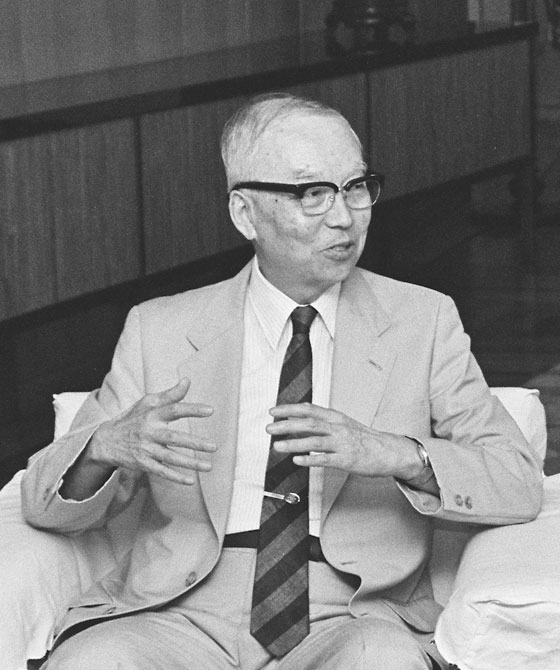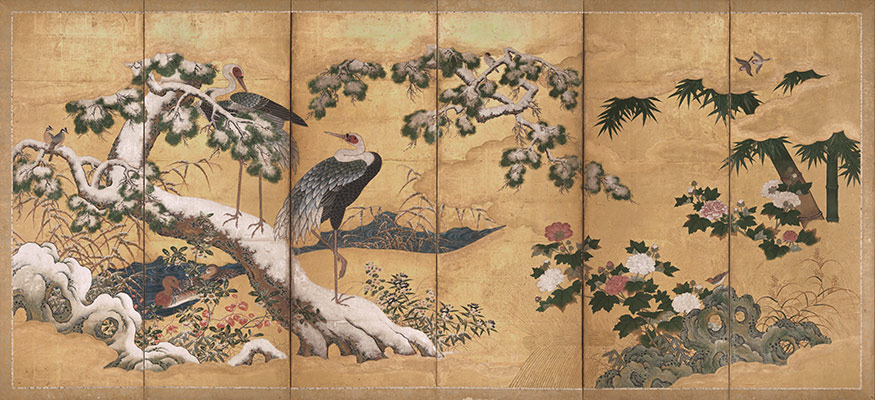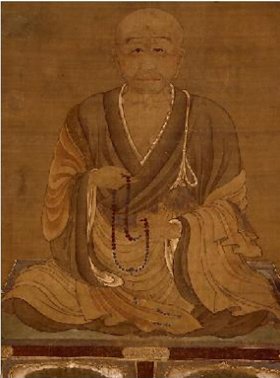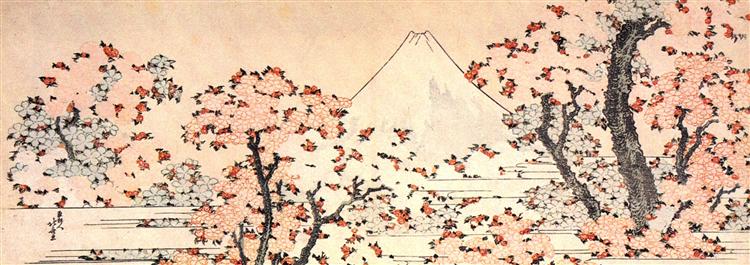
Japanese scholar Tamura Yoshiro (1921-1989) regarded the Sanju shika no kotogaki (Notes on Thirty Four Articles, hereafter referred to as the Kotogaki), an oral transmission text of the Eshin school [one of the two sub-schools that emerged within Tendai, the other being Danna] ”as a watershed work, in which all the concepts of mature hongaku thought were present … subsequent developments [were] merely those of systematization … The teachings contained in Kotogaki had been transmitted orally from master to disciple and were committed to writing by Kokuka (fl c.1150),” that is, the late Heian period, a date most scholars accept, with, however, the exception of Tamura himself, who places it around 1250.
In a text published in the Japanese Journal of Religious Studies (1987), Tamura writes: “Our life consists of two worlds, that is, the actual world (the phenomenal world) and the eternal world (the essential world). In the actual world, various kinds of activity and phenomena occur every day, which can be arranged dualistically into opposing factors,” say “A and B,” such as subject and object … life and death, good and evil, enlightenment and illusion, and so forth. These factors A and B, however, do not exist on their own with an eternally unchanging substance (atman, svabhava), but change interdependently on the principle of non-substantiality and emptiness (sunyata).” The interdependence of A and B on the principle of emptiness was expressed in terms of non-duality (advaya). This non-duality of A and B is the aspect of the eternal world,” but “Japanese Tendai Buddhism did not stop at this point, however, but “returned” to the actual world by affirming the dualistic aspects of this world in their totality.” At this point Tamura makes a distinction between two aspects of the world, “the existential aspect such as “life and death,” and second, the illusional aspect such as “Buddha and human being,” and states, “The Tendai concept of original enlightenment first affirmed the existential aspect, and then affirmed even the illusional aspect.”
Tamura regards this return to the actual world as due to the influence of the indigenous Japanese world view: “The first step is grounded in traditional Buddhist thought, while the second step, especially the affirmation of deluded humanity, oversteps the boundary of Buddhist thinking patterns and is due more to the influence of Japanese thinking patterns.” He argues that “Under the influence of the indigenous Japanese world view, the Tendai concept of original enlightenment steadily became an increasingly thorough affirmation of the actual world,” and explains that “in Japan the four seasons and climates change moderately, so that the close ties between human life and nature have been felt keenly since ancient times. This is the reason why the thought and culture indigenous to Japan has been rich in the area of accommodation to nature,” and “it was in the middle ages that this accommodation to the actual world developed into an affirmation of the actual world.” I feel that there is no denying that the Japanese people’s close ties with nature, evident in proto-Shinto and Shinto practices, must have played a role, but Jacqueline Stone is keen to insist that original enlightenment thought is a logical development of Buddhist Mahayana thinking. Couldn’t we say that, thanks to their indigenous culture, Japanese Buddhist thinkers were able to develop Mahayana logic to access deeper insights?
Tamura’s explanations about the two aspects of the world – the existential aspect, such as “life and death” and the illusional aspect such as “Buddha and human being” – lead to the assertion that “the world abides forever,” which many Buddhists would find suspicious, as well as the no less surprising statement that “no particular practice is necessary for enlightenment.”
Tamura writes: “With regard to the duality “life and death,” typical of the existential aspect, eternal or absolute life can be perceived in terms of the non-duality of life and death, a transcendence of the antagonism between life and death. If the “life and death” of this actual world is seen from the perspective of their nonduality, then not only life but also death is seen as an active figure of eternal life and as a manifestation of non-dualistic original enlightenment in this actual world. This affirmation of “life and death” (samsara) is understood as an affirmation of the transience of the actual world. The Sanju shika no kotogaki in commenting on the term “the world abides forever”from the Lotus Sutra, says that “the term ‘the world abides forever’ does not mean solidity and immobility. The world is transient and various. Transiency is transiency, though eternally abiding. Variety is variety, though eternally abiding.” In short, the transience and mutability of this world is an active figure of eternal life. Applied to the four seasons of nature, the poetic motto “Bloom and bloom, this is eternity; fall and fall, this is eternity” was created.”

As for the duality “Buddha and human being” typical of the illusional aspect, Tamura writes that “the absolute Buddha can be seen in the non-duality of Buddha and human being, transcending the antagonism between Buddha and people. If the duality of Buddha and human beings is seen from the perspective of this non-duality, then not only Buddha but also people are seen as manifestations of the absolute Buddha of non-duality in this actual world. In an extreme sense, human beings are indeed the Buddha living in the actual world, so that they are the true and real Buddha. The Buddha which transcends the actual world is an expedient and dead Buddha. Thus people with their illusion are affirmed as they are, and no particular practice is necessary for enlightenment.
While she agrees with much of Tamura’s understanding of original enlightenment, and quotes him on several occasions in her book, Jacqueline Stone is quick to raise a few questions: is practice really not required? does it amount to a affirmation of all things? what about the problem of wrongdoing and delusion?

Stone agrees with Tamura’s description of original enlightenment as the result of two successive moves. She finds that the first move is better articulated in the Shinnyo kan (The Contemplation of Suchness), “almost certainly written during the 12th century” though “attributed to the great Tendai Pure Land teacher Genshin (942-1017).”
“The theme of the Shinnyo kan is the immediate realization of Buddhahood by awakening to the universal reality of suchness (Jpn shinnyo, Skt tathata) or – as the text alternatively phrases it – “suchness” that is original enlightenment (hongaku shinnyo).” The term “suchness” is equated in this text with the true aspect, the dharma realm (dharma-dhatu), the Dharma body (hosshin, dharmakaya), the Dharma nature (hossho, dharmata), the Tathagata (nyorai), and the cardinal meaning (daiichi gi). “Suchness is not an ontological substrate but all things being empty and thus mutually encompassing.”
“Suchness” is indeed the key word that negates the difference between what Tamura called “the eternal world” (ultimate reality, emptiness) and the actual world (phenomena, which are empty of inherent existence and interdependent). Both are “suchness,” “empty and thus mutually encompassing.”
Stone then quotes a series of passages from the Tendai “Hongaku ron” (THR): “If you wish to realize Buddhahood quickly … you must think that your own mind is precisely the principle of suchness.” Also, “Though the dharmas in number are incalculable and boundless, none is separate from the principle of suchness. Moreover, because the myriad dharmas interpenetrate to form the whole, we speak of the principle of all dharmas being a single suchness. This being the case, the worldly passions are none other than enlightenment; birth and death are precisely the Dharma body and our evil karma is precisely liberation … Moreover, of all insentient beings, the grasses and trees, mountains and rivers, the great ocean and the empty sky – there is none that is not suchness. Because all these are suchness, they are all Buddha. Suchness is the real Buddha.”
This is what Tamura had described as a “dissolution of distinctions, based on the insight that all phenomena are without independent ontological status” – that is, phenomena are all equally “suchness” (empty and interdependent) – both ontologically unreal. This, however, is still an abstract view based on the Awakening of Faith, what the Kotogaki refers to as “principle.”
Stone says that the second move is better described in the Kotogaki as “the distinction between the nondifferentiated, equal aspect of things, and their individuated, phenomenal aspect, [which] is itself negated. This creates the “reversed move” in which individual concrete phenomena, just as they are, are “affirmed” as the manifestation of nondual reality.” It is, as Tamura had indicated, a “return to the actual world,” understood in existential terms, not in “objective” terms as our western minds are used to.
The Kotogaki speaks of these two perspectives in terms of “principle” and “actuality.” “You should understand carefully what is meant by principle (ri) and by concrete actuality (ji). “Principle” means that, although the dharmas have distinctions, because they are all suchness, they are resolved in the one … With respect to principle, there are no distinctions whatsoever; the myriad dharmas are dissolved. But with respect to actuality, the myriad dharmas are not dissolved. They remain constant in themselves” (THR).
Stone agrees with Tamura that “the constant abiding of the phenomenal world” is not, as it might at first appear to be, a flat denial of Buddhist notions of impermanence …’Constantly abides’ here does not mean being fixed and immobile. Impermanence, while being impermanence, constantly abides and is not lost.”
While Tamura was keen to connect this return to the phenomenal world as due to the influence of the indigenous Japanese worldview,” Stone, like the Tendai monks, relates this revalorisation of phenomena to the Lotus Sutra, in particular to the Original Buddha as he appears in Chapter 16. This Original Buddha had to play the role Mahavairocana/Dainishi Buddha played in esoteric teachings. In Kukai’s works, Dainishi “is” the universe, the whole of reality. He is not an independently existing agent who has created the universe, and still rules it, as God is said to be doing in the West. The universe is a set of interdependent actions or processes. Kukai describes Dainishi as hosshin seppo (“the buddha-as-cosmos expounds the truth”). The universe – i.e., all phenomena – “preaches.”
In the words of the Kotogaki, “To see the Buddha in his manifested trace (that is, the historical Buddha of the first fourteen chapters of the Lotus Sutra) is to see the Buddha in his original ground. To see the moon in the water is to see the moon in the sky. Ignorant people do not know this … One does not see in the water a reflected moon; one directly sees the moon in the sky. It is the same with the trace teaching. There is no separate, manifested trace Buddha. There is only the original Buddha.”
The original Buddha as the dharmakaya is the world of phenomena, “empty and thus mutually encompassing.” “He” is suchness and our teacher.
In the concluding chapter on Original Enlightenment Thought, Stone criticises Tamura’s “absolute affirmation of the phenomenal world and its corollary that we do not need to practice. She writes:
“Tendai original enlightenment thought has been widely understood by modern scholars as an absolute affirmation of the phenomenal world that in effect denied the necessity of Buddhist practice and legitimated evil conduct. And as a corollary, the new Kamakura Buddhist movements are said to have arisen, at least in part, as a corrective to this trend.” Stone does not agree with this view.
“Hongaku thought has been called a doctrine of “absolute affirmation” in that all phenomena, including one’s most ordinary acts and deluded thoughts, just as they are, are seen as the expressions of original enlightenment. However, this statement requires some qualifications. Being committed to a nondual position, hongaku rhetoric strives to collapse any tension … between the visible phenomena of this world and ultimate reality, or between the Buddha’s enlightenment and the state of ordinary worldlings. But a close reading of texts suggests that such statements as “the defilements are none other than enlightened insight” are articulated from the standpoint of having realized nonduality, not that of having yet to realize it … It is only from the standpoint of this nondual insight that the hongaku doctrine may be accurately characterized as “absolute affirmation.”
“Failure to grasp this qualification has led to the questionable assumption that original Enlightenment thought, in its “absolute affirmation” of the enlightenment of ordinary worldlings just as they are, in effect denies the need for practice. This charge should now be laid to rest. Tendai kuden transmissions make clear that statements about “nothing to practice and nothing to achieve” were to convey some sense of what an enlightened person is supposed to see, or to repudiate purely functional understandings of practice as a means to an end – not to deny its necessity. Because original enlightenment is seen as the true status of all phenomena, practice cannot be the “cause” of enlightenment.” Medieval Tendai monks have indeed engaged in diverse forms of religious practice.
“Since Tendai hongaku thought does not deny the necessity of Buddhist practice, the new Kamakura schools cannot accurately be characterized as a countermovement to revive it. This notion, too, should be allowed to lapse permanently.” In fact, it is because it has become widely accepted that enlightenment had to be “actualised” rather than “achieved,” through a cutting off attachments that Pure Land, Zen and Nichiren schools were led to focus on practices such as mantras or shikantaza. Such practices were meant to trigger an experience of inner contentment and peace that no acquired “thing” could match. Rather than expecting ethics to lead to enlightenment, insights into experiences of enlightenment was relied upon to achieve ethics, through the embodiment of the enlightened mind.
Stone feels that, as both academics and practitioners in the West have almost exclusively focused on the new schools of the Kamakura period, they have failed to appreciate the profound formative influence of the Heian period. “The hongaku discourse flourished for some six hundred years, from the Heian through the mid-Togukawa periods.” “All the significant features of hongaku discourse – the direct accessibility of Buddhahood, the concern for people of limited capacity, the “shortening of the path,” the equation of worldly phenomena with Buddhist truth, the weakening of the causal links between moral conduct and liberation – can be traced to the Heian period … In one sense, it is still with us, for the doctrinal orthodoxy of many Japanese Buddhist traditions today retains a hongaku orientation in holding that liberation is accessed in the act of practice.”
Source:
Jacqueline I. Stone – Original Enlightenment and the Transformation of Medieval Japanese Buddhism

